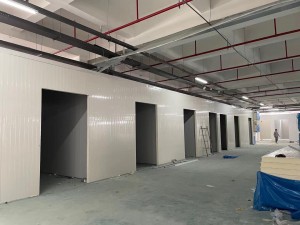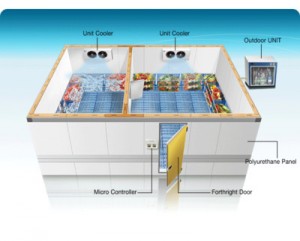Cold storage is a high-energy consumption industry in the cold processing and food preservation industries. The energy consumption of the cold storage enclosure structure accounts for about 30% of the entire cold storage. The cooling capacity of some low-temperature cold storage enclosure structures is as high as about 50% of the total load of the refrigeration equipment. To reduce the cooling capacity loss of the cold storage enclosure structure, the key is to reasonably set the insulation layer of the enclosure structure.
01. Reasonable design of the insulation layer of the cold storage enclosure structure
The material used for the insulation layer and its thickness are the most important factors affecting the heat input, and the design of the insulation project is the key to affecting the civil engineering cost. Although the design of the cold storage insulation layer must be analyzed and determined from both technical and economic perspectives, practice has shown that the “quality” of the insulation material must be given priority, and then the “low price”. We should not only look at the immediate benefits of saving initial investment, but also consider long-term energy saving and consumption reduction.
In recent years, most of the prefabricated cold storage designed and built use rigid polyurethane (PUR) and extruded polystyrene XPS as insulation layers [2]. Combining the advantages of PUR and XPS’ superior thermal insulation performance and the high D value of the thermal inertia index of brick-concrete structure, the civil engineering type single-sided color steel plate composite internal thermal insulation layer structure is a recommended construction method for the insulation layer of the cold storage enclosure structure.
The specific method is: use the brick-concrete structure exterior wall, make a vapor and moisture barrier layer after cement mortar is leveled, and then make a polyurethane insulation layer on the inside. For the major renovation of the old cold storage, this is a building energy-saving solution that is worthy of optimization.

02. Design and layout of process pipelines:
It is inevitable that refrigeration pipelines and lighting power pipelines pass through the insulated exterior wall. Each additional crossing point is equivalent to opening an additional gap in the insulated exterior wall, and the processing is complicated, the construction operation is difficult, and it may even leave hidden dangers to the quality of the project. Therefore, in the pipeline design and layout plan, the number of holes passing through the insulated exterior wall should be reduced as much as possible, and the insulation structure at the wall penetration should be carefully handled.
03. Energy saving in cold storage door design and management:
Cold storage door is one of the supporting facilities of cold storage and is the part of the cold storage enclosure structure that is most prone to cold leakage. According to relevant information, the cold storage door of the low-temperature storage warehouse is opened for 4 hours under the conditions of 34 ℃ outside the warehouse and -20 ℃ inside the warehouse, and the cooling capacity reaches 1 088 kcal/h.
The cold storage is in an environment of low temperature and high humidity and frequent changes in temperature and humidity all year round. The temperature difference between the inside and outside of the low-temperature storage is usually between 40 and 60 ℃. When the door is opened, the air outside the warehouse will flow into the warehouse because the air temperature outside the warehouse is high and the water vapor pressure is high, while the air temperature inside the warehouse is low and the water vapor pressure is low.

When the hot air with high temperature and high humidity outside the warehouse enters the warehouse through the cold storage door, a large amount of heat and moisture exchange will aggravate the frost of the air cooler or evaporation exhaust pipe, resulting in a decrease in evaporation efficiency, thereby causing temperature fluctuations in the warehouse and affecting the quality of stored products.
The energy-saving measures for cold storage doors mainly include:
① The area of the cold storage door should be minimized during design, especially the height of the cold storage door should be reduced, because the cold loss in the height direction of the cold storage door is much greater than that in the width direction. Under the condition of ensuring the height of the incoming goods, select the appropriate ratio of the door opening clearance height and clearance width, and minimize the clearance area of the cold storage door opening to achieve a better energy-saving effect;
② When the cold storage door is opened, the cold loss is proportional to the clearance area of the door opening. Under the premise of meeting the inflow and outflow volume of goods, the automation degree of the cold storage door should be improved and the cold storage door should be closed in time;
③ Install a cold air curtain, and start the cold air curtain operation when the cold storage door is opened by using a travel switch;
④ Install a flexible PVC strip door curtain in a metal sliding door with good thermal insulation performance. The specific approach is: when the door opening height is below 2.2 m and people and trolleys are used to pass through, flexible PVC strips with a width of 200 mm and a thickness of 3 mm can be used. The higher the overlap rate between the strips, the better, so that the gaps between the strips are minimized; for door openings with a height greater than 3.5 m, the strip width can be 300~400 mm.
Post time: Jun-14-2025




